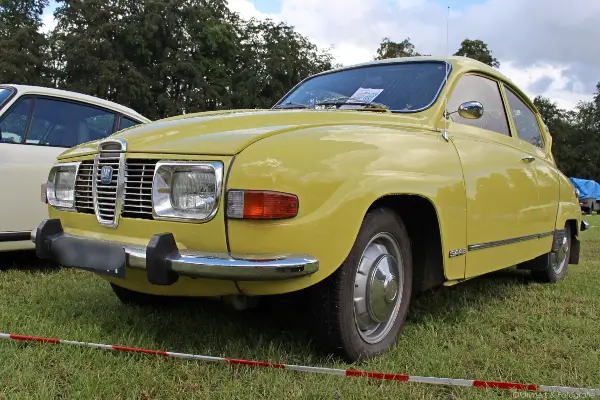Saab Tyres
Classic Saab Tyres
On the following pages, Longstone Classic Tyres give classic tyre fitment recommendations for Saab cars.
01302 711 123
or
Email: sales@longstonetyres.co.uk
Vintage Saab Tyres
Longstone Tyres can provide tyres for across the whole Saab range, from the ahead of its time Saab 96 to the luxury Saab 99.
Saab Tyres
The following list are our recommendations for Saabs:
- 145 SR 15 Michelin XZX for a Saab 93.
- 145 SR 15 Michelin XZX for a Saab 96.
- 155 HR 15 PIRELLI CINTURATO CA67 for a Saab 96 V4.
- 165-15 Michelin XAS for a Saab 99.
- 155 HR 15 PIRELLI CINTURATO CA67 for a Saab 99L.
- 175/70 WR 15 PIRELLI CINTURATO CN36 for a Saab 99 EMS, 99 Turbo.
Saab History

Saab AB, is a Swedish aerospace and defence business founded in Linköping in 1937. The firm was founded in 1937 with the explicit intention of producing aircraft for the Swedish Air Force in order to maintain the country's neutrality as Europe approached World War II. As the war came to an end and the demand for fighter planes appeared to be dwindling, the business began exploring for other industries to diversify into.
In 1945, the internal codename "X9248" was assigned to a vehicle design project. The design project was formally known as "Project 92" with the 92 following the Saab 91, a single-engine training aircraft, in the manufacturing sequence. In 1948, a corporate site in Trollhättan was renovated to accommodate automotive assembly, and the project, as well as the car production headquarters, relocated there.
In December 1949, the Saab 92 entered into production. Through the mid-1950s, 20,000 automobiles were sold. In 1955, the 92 was completely rebuilt and re-engineered, and it was dubbed the "Saab 93" The engine was upgraded from two to three cylinders, and the front bodywork was the first to have the initial generation of Saab's signature trapezoidal radiator grill. In 1959, a waggon model, the Saab 95, was launched. The decade also saw the introduction of Saab's first performance vehicle, the Saab 94, the first of the Saab Sonetts.

The Saab 96 was the third significant upgrade to the 92's basis, introduced in 1960. The 96 was a significant model for Saab since it was the first Saab that was widely exported outside of Sweden. The quirky car was a huge success, selling roughly 550,000 units. Unlike other American automobiles of the time, the 93, 95, and 96 all had a 3-cylinder 2-cycle engine that needed pumping oil to the gas tank, front-wheel drive, and freewheeling, which enabled the operator to downshift the on-the-column manual changer without touching the clutch. Front seat shoulder belts were another early addition.
The Saab 99, introduced in 1968, was even more significant to the company's fortunes. The 99 was the first all-new Saab in 19 years, and it marked a clear departure from the 92. The 99 introduced several advancements and features that would come to characterise Saabs for decades, including a wraparound windshield, self-repairing bumpers, headlight washers, and side-impact door beams. Sixten Sason's design was as groundbreaking as the underlying technology, and aspects like the Saab hockey stick profile logo continue to affect Saab's design language.
Under the Wallenberg family umbrella, Saab AB amalgamated with the Swedish industrial vehicle manufacturer Scania-Vabis AB in 1969 to establish Saab-Scania AB. In 1973, the 99 lineup was expanded with the inclusion of a combi coupe variant, a body shape that became iconic with Saab. In 1976, the millionth Saab vehicle was made. In 1978, Saab and Fiat agreed to market a rebranded Lancia Delta as the Saab 600 and jointly design a new platform. The arrangement resulted in the 1985 Saab 9000, a sister vehicle to the Alfa Romeo 164, Fiat Croma, and Lancia Thema, all of which rode on a shared Type Four chassis. The 9000 was Saab's first real luxury automobile, however, it did not sell as well as expected.

The Saab 900, the 99's successor, was also introduced in 1978. The 900 would sell almost one million units, making it Saab's best-selling and most recognisable vehicle. In 1986, a popular convertible variant appeared, all of which were produced in the Saab-Valmet facility in Finland, accounting for approximately 20% of the 900 sales. The "classic 900" has a cult following even today. Saab-vehicle Scania's segment was reorganised as a separate corporation, Saab Automobile AB, in 1989. General Motors (GM) of the United States acquired a 50% stake. The Saab 9-3 and the Saab 9-5 were two well-known vehicles from this era.
Saab failed to expand its consumer base beyond its niche following after many years of creating a solid engineering record and, eventually, a premium price tag. Following the collapse of a Chinese consortium to negotiate an acquisition of the firm, the company filed for bankruptcy after battling to avoid insolvency throughout 2011.



